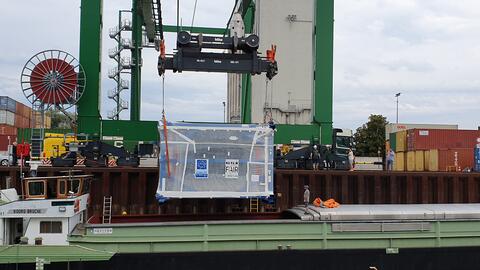CERN’s LHCb experiment has donated its decommissioned outer tracker detector component to PANDA.
PANDA is happy about a gift it has received from LHCb, one of the four big CERN experiments at the Large Hadron Collider. LHCb has sent their decommissioned Outer Tracker (OT) from Geneva to Darmstadt, where it has arrived at GSI (25. August 2023) after a special transport of five days via truck and ship. The LHCb colleagues at CERN prepared the detector in its transport frame with protecting plastic for a journey in three stages, due to the "package" size: Seven meter long, 3.5 meter wide, 5.5 meter high and a weight of 24 tons. The first stage of the journey by truck brought the OT from CERN to the harbour of Colmar where a Rhine ship took over the second stage and delivered the OT to Gernsheim harbour, where a truck did the last stage to GSI.
The donation from LHCb to PANDA was initiated by by our deputy technical coordinator Anastasios "Tassos" Belias and Niels Tuning from LHCb/CERN after discussions about spare detector modules at a conference a few years ago.
Finally the LHCb collaboration decided to donate the whole OT to the PANDA collaboration, which was then formally signed in a contract between GSI and CERN/LHCb last year.
The donation was made possible thanks to the close cooperation in logistics and technical aspects between several colleagues at CERN and GSI/FAIR, in particular Niels Tuning (LHCb, Nikhef/CERN) and Anastasios Belias (PANDA, GSI/FAIR) and their relentless efforts to give the formidable outer tracker a second life. The donation was kindly agreed upon by the LHCb groups who meticulously built and operated the outer tracker, namely,
- the National Institute for Subatomic Physics, Nikhef, the Netherlands,
- the Physikalisches Institut der Universität Heidelberg, Germany,
- the National Centre for Nuclear Research, Warsaw, Poland,
- the Henryk Niewodniczanski Institute of Nuclear Physics, Polish Academy of Sciences, Krakow, Poland,
- and the Technische Universität Dortmund, Germany.
The OT consists of 54.000 Straw tubes, each 2.4 m long with a diameter of 5 mm, which are arranged in staggered double layers and mounted to twelve C-shaped mechanical frames. The C-frames are inserted in the big blue transport frame (c.f. pictures).
There are several ideas how individual parts of the OT can be re-used in different experiments and set-ups in the future.
At PANDA the tracker will be able to detect the light hadrons produced by the collisions. Hadron spectroscopy is where the physics goals of LHCb and PANDA overlap, and the two will be able to collect complementary data that can later be analysed and compared. The tracker will also be used by students and young researchers in R&D projects, as well as in outreach activities for schools and the general public.






